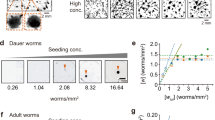Abstract
The classical chemostat models of Monod and others were designed for unicellular organisms. We summarize evidence that these models are not adequate for the rotifer chemostat, then propose a new, physiologically structured model that resolves some of their key problems yet remains biologically simple. The new model includes separate ontogenetic stages for eggs and free-swimming rotifers, with generalized age structure in the egg stage and body mass structure in the free-swimming stage. We present several numerical examples to illustrate the model’s behavior, and we compare these in a preliminary way with experimental evidence from the literature.
Access this chapter
Tax calculation will be finalised at checkout
Purchases are for personal use only
Preview
Unable to display preview. Download preview PDF.
Similar content being viewed by others
References
Bennett, W. N. & M. E. Boraas, 1989. Comparison of population dynamics between slow-and fast-growing strains of the rotifer Brachionus calyciflorus Pallas in continuous culture. Oecologia 81:494–500.
Boraas, M. E., 1979. Dynamics of Nitrate, Algae, and Rotifers in Continuous Culture: Experiments and Model Simulations. Ph.D. thesis, Pennsylvania State University.
Boraas, M. E., 1983. Population dynamics of food-limited rotifers in two-stage chemostat culture. Limnol. Oceanogr. 28: 546–563.
Boraas, M. E., D. B. Seale, J. E. Boxhorn & J. N. McNair, 1998. Rotifer size distribution changes during transient phases in open cultures. Hydrobiologia 387/388 (Dev. Hydrobiol. 134): 477–482.
Herbert, D., 1958. Some principles of continuous culture. In G. Tunevall (ed.), Recent Progress in Microbiology. Blackwell, London: 381–396.
Monod, J., 1950. La technique de culture continue; theorie et applications. Ann. Inst. Pasteur, Lille 79: 390–410.
Rothaupt, K. O., 1993. Critical consideration of chemostat experiments. In N. Walz (ed.), Plankton Regulation Dynamics. Springer-Verlag, New York: 217–225.
Walz, N., 1993. Model simulations of continuous rotifer cultures. Hydrobiologia 255/256: 165–170.
Author information
Authors and Affiliations
Editor information
Rights and permissions
Copyright information
© 1998 Springer Science+Business Media Dordrecht
About this paper
Cite this paper
McNair, J.N., Boraas, M.E., Seale, D.B. (1998). Size-structure dynamics of the rotifer chemostat: a simple physiologically structured model. In: Wurdak, E., Wallace, R., Segers, H. (eds) Rotifera VIII: A Comparative Approach. Developments in Hydrobiology, vol 134. Springer, Dordrecht. https://doi.org/10.1007/978-94-011-4782-8_60
Download citation
DOI: https://doi.org/10.1007/978-94-011-4782-8_60
Publisher Name: Springer, Dordrecht
Print ISBN: 978-94-010-6009-7
Online ISBN: 978-94-011-4782-8
eBook Packages: Springer Book Archive




